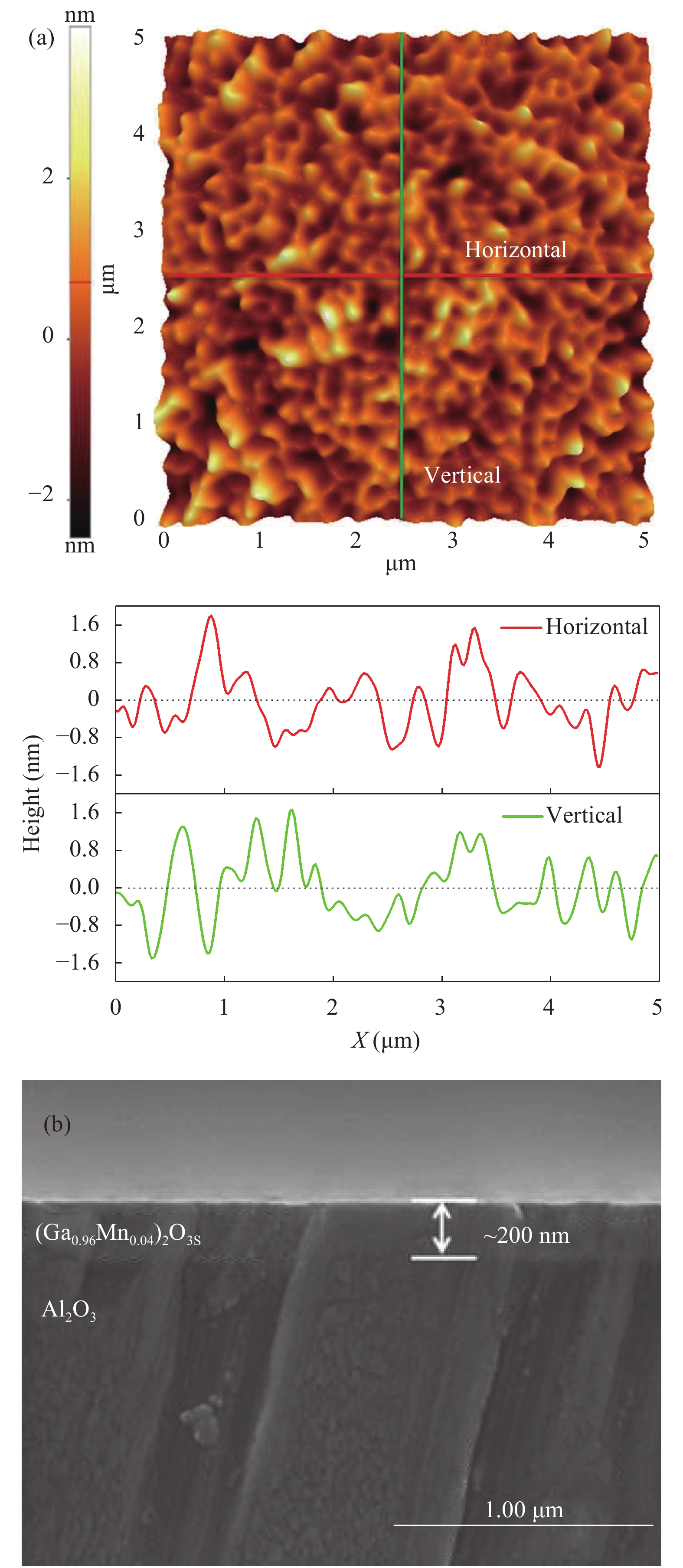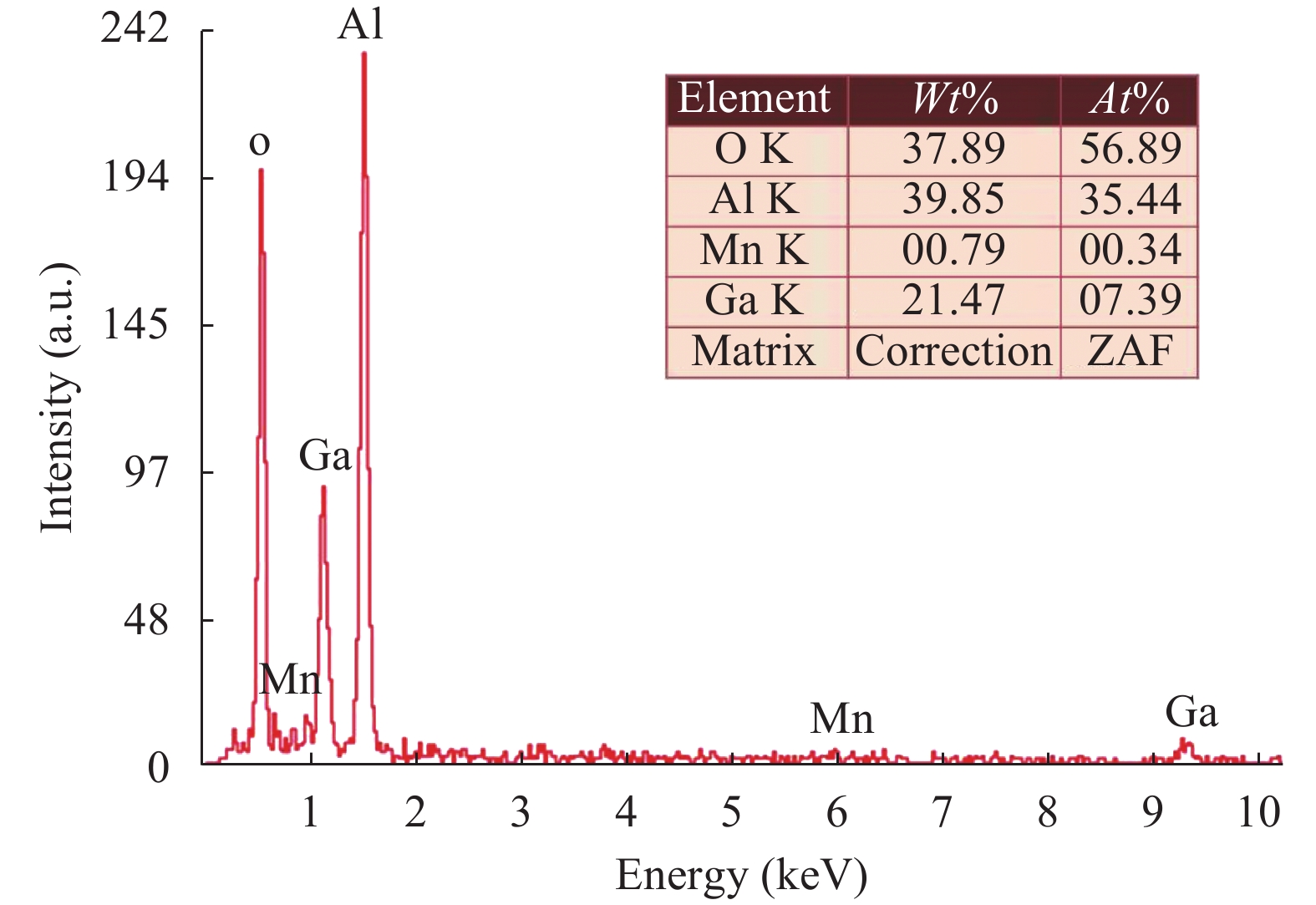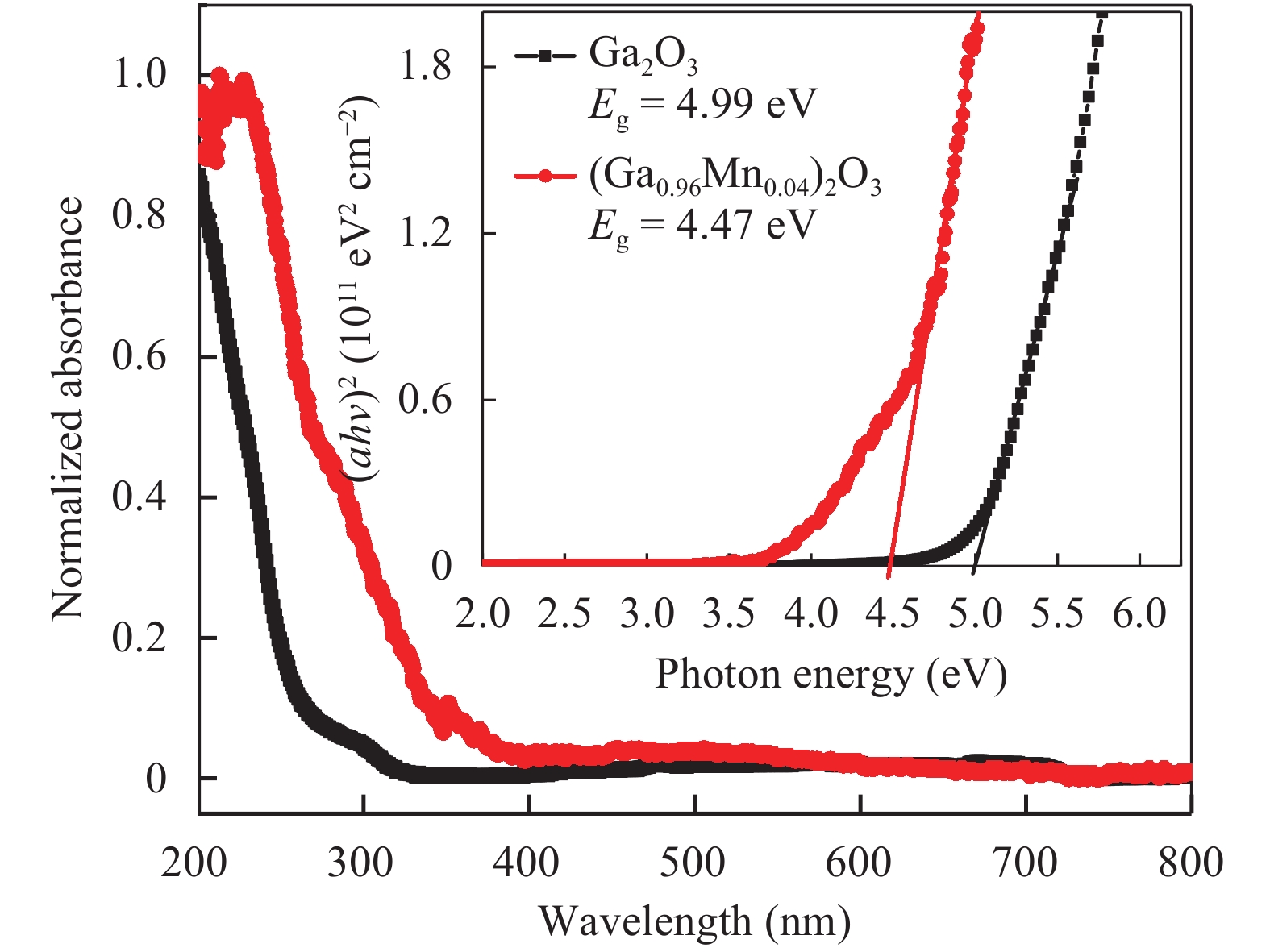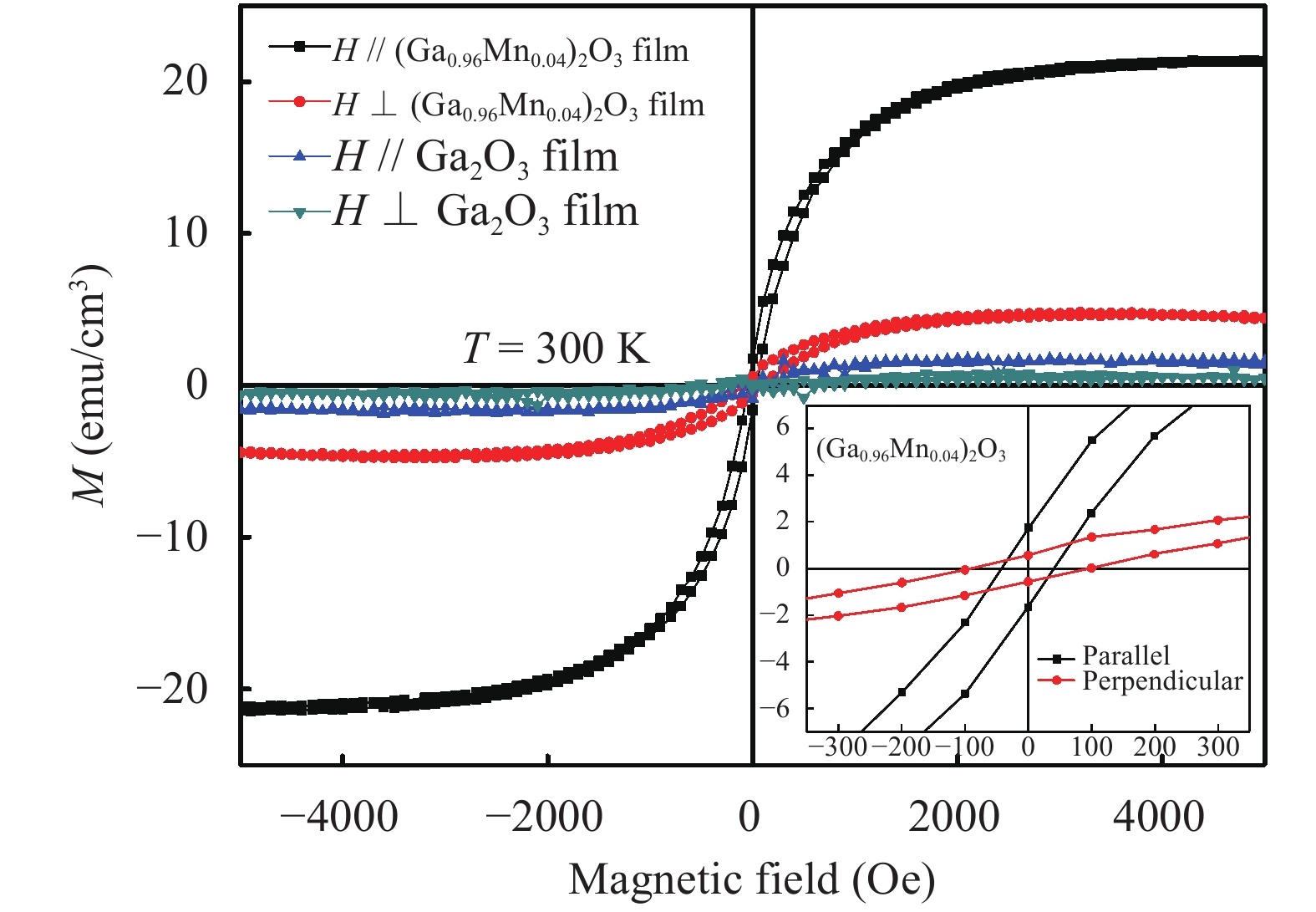| Citation: |
Yuanqi Huang, Zhengwei Chen, Xiao Zhang, Xiaolong Wang, Yusong Zhi, Zhenping Wu, Weihua Tang. The structure and magnetic properties of β-(Ga0.96Mn0.04)2O3 thin film[J]. Journal of Semiconductors, 2018, 39(5): 053002. doi: 10.1088/1674-4926/39/5/053002
****
Y Q Huang, Z W Chen, X Zhang, X L Wang, Y S Zhi, Z P Wu, W H Tang. The structure and magnetic properties of β-(Ga0.96Mn0.04)2O3 thin film[J]. J. Semicond., 2018, 39(5): 053002. doi: 10.1088/1674-4926/39/5/053002.
|
The structure and magnetic properties of β-(Ga0.96Mn0.04)2O3 thin film
DOI: 10.1088/1674-4926/39/5/053002
More Information
-
Abstract
High quality epitaxial single phase (Ga0.96Mn0.04)2O3 and Ga2O3 thin films have been prepared on sapphire substrates by using laser molecular beam epitaxy (L-MBE). X-ray diffraction results indicate that the thin films have the monoclinic structure with a$\left( {\bar 201} \right)$ preferable orientation. Room temperature (RT) ferromagnetism appears and the magnetic properties of β-(Ga0.96Mn0.04)2O3 thin film are enhanced compared with our previous works. Experiments as well as the first principle method are used to explain the role of Mn dopant on the structure and magnetic properties of the thin films. The ferromagnetic properties are explained based on the concentration of transition element and the defects in the thin films.-
Keywords:
- L-MBE,
- epitaxial growth,
- Mn doped Ga2O3 thin film,
- RT ferromagnetism
-
References
[1] Wolf S A, Awschalom D D, Buhrman R A, et al. Spintronics: a spin-based electronics vision for the future. Science, 2001, 294(5546): 1488 doi: 10.1126/science.1065389[2] Fusil S, Garcia V, Barthélémy A, et al. Magneto electric devices for spintronics. Ann Rev Mater Res, 2014, 44: 91 doi: 10.1146/annurev-matsci-070813-113315[3] Suzuki R, Nakagomi S, Kokubun Y. Solar-blind photodiodes composed of an Au Schottky contact and a β-Ga2O3 single crystal with a high resistivity cap layer. Appl Phys Lett, 2011, 98(13): 131114 doi: 10.1063/1.3574911[4] Feng P, Zhang J Y, Li Q H, et al. Individual β-Ga2O3 nanowires as solar-blind photodetectors. Appl Phys Lett, 2006, 88(15): 153107 doi: 10.1063/1.2193463[5] Guo D Y, Wu Z P, Li P G, et al. Magnetic anisotropy and deep ultraviolet photoresponse characteristics in Ga2O3:Cr vermicular nanowire thin film nanostructure. RSC Adv, 2015, 5(17): 12894 doi: 10.1039/C4RA13813A[6] Ye S Y, Zhang Y H, He H L, et al. Simultaneous broadband near-infrared emission and magnetic properties of single phase Ni2+-doped β-Ga2O3 nanocrystals via mediated phase-controlled synthesis. J Mater Chem C, 2015, 3(12): 2886 doi: 10.1039/C4TC02624A[7] Chikoidze E, Bardeleben H J V, Akaiwa K, et al. Electrical, optical, and magnetic properties of Sn doped α-Ga2O3 thin films. J Appl Phys, 2016, 120(2): 025109 doi: 10.1063/1.4958860[8] Guo D Y, An Y H, Cui W, et al. Epitaxial growth and magnetic properties of ultraviolet transparent Ga2O3/(Ga1-xFex)2O3 multilayer thin films. Sci Rep, 2016, 6: 25166 doi: 10.1038/srep25166[9] Minami T, Shirai T, Nakatani T, et al. Electroluminescent devices with Ga2O3:Mn thin-film emitting layer prepared by sol-gel process. Jpn J Appl Phys, 2000, 39(6A): L524 doi: 10.1143/JJAP.39.L524[10] Minami T. Oxide thin-film electroluminescent devices and materials. Solid-State Electron, 2003, 47(12): 2237 doi: 10.1016/S0038-1101(03)00204-1[11] Kim J H, Yoon K H. Influence of post-deposition annealing on the microstructure and properties of Ga2O3:Mn thin films deposited by RF planar magnetron sputtering. J Mater Sci: Mater Electron, 2009, 20(9): 879 doi: 10.1007/s10854-008-9810-2[12] Hayashi H, Huang R, Ikeno H, et al. Room temperature ferromagnetism in Mn-doped γ-Ga2O3 with spinel structure. Appl Phys Lett, 2006, 89(18): 181903 doi: 10.1063/1.2369541[13] Hayashi H, Huang R, Oba F, et al. Site preference of cation vacancies in Mn-doped Ga2O3 with defective spinel structure. Appl Phys Lett, 2012, 101(24): 241906 doi: 10.1063/1.4770363[14] Guo D Y, Wu Z P, An Y H, et al. Room temperature ferromagnetism in (Ga1–xMnx)2O3 epitaxial thin films. J Mater Chem C, 2015, 3(8): 1830 doi: 10.1039/C4TC02833C[15] Guo D Y, Li P G, Wu Z P, et al. Inhibition of unintentional extra carriers by Mn valence change for high insulating devices. Sci Rep, 2016, 6: 24190 doi: 10.1038/srep24190[16] Dakhel A A. Structural, optical, and opto-dielectric properties of W-doped Ga2O3 thin films. J Mater Sci, 2012, 47(7): 3034 doi: 10.1007/s10853-011-6134-z[17] Guo D Y, Qian Y P, Su Y L, et al. Evidence for the bias-driven migration of oxygen vacancies in amorphous non-stoichiometric gallium oxide. AIP Adv, 2017, 7(6): 065312 doi: 10.1063/1.4990566[18] Guo D Y, Liu H, Li P G, et al. Zero-power-consumption solar-blind photodetector based on β-Ga2O3/NSTO heterojunction. ACS Appl Mater Interf, 2017, 9(2): 1619-1628 doi: 10.1021/acsami.6b13771[19] Guo D Y, Wu Z P, Li P G, et al. Fabrication of β-Ga2O3 thin films and solar-blind photodetectors by laser MBE technology. Opt Mater Express, 2014, 4(5): 1067 doi: 10.1364/OME.4.001067[20] An Y H, Zhi Y S, Cui W, et al. Thickness tuning photoelectric properties of β-Ga2O3 thin film base photodetectors. J Nanosci Nanotechnol, 2017, 17: 1 doi: 10.1166/jnn.2017.12932[21] Chen Z W, Saito K, Tanaka T, et al. Low temperature growth of europium doped Ga2O3 luminescent films. J Cryst Growth, 2015, 430: 28 doi: 10.1016/j.jcrysgro.2015.08.020[22] An Y K, Wang S Q, Duan L S, et al. Local Mn structure and room temperature ferromagnetism in Mn-doped In2O3 films. Appl Phys Lett, 2013, 102(21): 212411 doi: 10.1063/1.4808116[23] Kokubun Y, Miura K, Endo F, et al. Sol-gel prepared β-Ga2O3 thin films for ultraviolet photodetectors. Appl Phys Lett, 2007, 90(3): 031912 doi: 10.1063/1.2432946[24] Riesz F, Vignali C, Pelosi C, et al. An atomic force microscopy study of the surface morphology of InP/GaAs heteroepitaxial layers subjected to rapid thermal annealing. J Appl Phys, 1998, 83(1): 246 doi: 10.1063/1.366733[25] Álvarez D, Hartwich J, Kretz J, et al. Scanning spreading resistance microscopy of fully depleted silicon-on-insulator devices. Microelectron Eng, 2003, 67(1): 945[26] Evarts E R, Cao L, Ricketts D S, et al. Spin transfer torque switching of magnetic tunnel junctions using a conductive atomic force microscope. Appl Phys Lett, 2009, 95(13): 132510 doi: 10.1063/1.3240884[27] Guo L J, Shen X P, Zhu G X, et al. Preparation and gas-sensing performance of In2O3 porous nanoplatelets. Sens Actuators B, 2011, 155(2): 752 doi: 10.1016/j.snb.2011.01.042[28] Kumar S S, Rubio E J, Nooraalam M, et al. Structure, morphology, and optical properties of amorphous and nanocrystalline gallium oxide thin films. J Phys Chem C, 2013, 117(8): 4194 doi: 10.1021/jp311300e[29] Giri P K. Structural, optical and magnetic properties of Ni doped ZnO nanoparticles: correlation of magnetic moment with defect density. Appl Surf Sci, 2015, 356: 804 doi: 10.1016/j.apsusc.2015.08.163[30] Chen Y, Wu B, Yuan H K, et al. The defect-induced changes of the electronic and magnetic properties in the inverse Heusler alloy Ti2CoAl. J Solid State Chem, 2015, 221(221): 311 doi: 10.1016/j.jssc.2014.08.027[31] Murugan R, Vijayaprasath G, Mahalingam T, et al. Defect induced magnetic transition in Co doped CeO2, sputtered thin films. Ceram Int, 2016, 42(10): 11724 doi: 10.1016/j.ceramint.2016.04.091[32] Pei G Q, Xia C T, Dong Y J, et al. Studies of magnetic interactions in Mn-doped β-Ga2O3 from first-principles calculations. Scripta Materialia, 2008, 58(11): 943 doi: 10.1016/j.scriptamat.2008.01.059[33] Lovejoy T C, Chen R, Yitamben E N, et al. Incorporation, valence state, and electronic structure of Mn and Cr in bulk single crystal β-Ga2O3. J Appl Phys, 2012, 111(12): 123716 doi: 10.1063/1.4729289[34] Wang G F, Li Y J, Zhong D X, et al. Study of effects of heavy Mn doping on electronic structure and optical property of β-Ga2O3 with the first principle. Journal of Zhejiang Sci-Tech University, 2014, 31(5): 586 -
Proportional views







 DownLoad:
DownLoad:



















